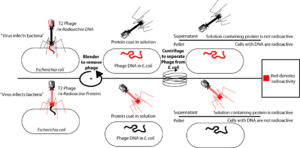Hershey–Chase experiment facts for kids
The Hershey–Chase experiments were a set of important scientific tests carried out in 1952. Two scientists, Alfred Hershey and Martha Chase, performed these experiments. Their main goal was to prove that DNA (deoxyribonucleic acid) is the material that carries genetic information. This means DNA tells living things how to grow and what traits they will have.
Before these experiments, scientists weren't completely sure if DNA or proteins were the genetic material. A Swiss doctor named Friedrich Miescher had first discovered DNA between 1868 and 1869. He found it while studying white blood cells. Alfred Hershey later shared the 1969 Nobel Prize in Physiology or Medicine for his discoveries about the genetic makeup of viruses.
Contents
How the Experiment Worked
Hershey and Chase used a special type of virus called T2 phage for their experiments. A phage is a virus that infects bacteria. It works by attaching itself to a bacterium and then injecting its genetic material inside.
Tracking DNA with Phosphorus
In their first test, the scientists wanted to track the DNA. They used a special, slightly radioactive version of Phosphorus called Phosphorus-32. This radioactive phosphorus was used to "label" the DNA of the phages. DNA contains phosphorus, but proteins do not.
They let these labeled phages infect E. coli bacteria. After the infection, they separated the phages from the bacteria. When they checked, they found the radioactive phosphorus only inside the bacteria. This showed that the DNA had entered the bacteria.
Tracking Protein with Sulfur
In a second test, Hershey and Chase wanted to track the proteins. They used a radioactive version of Sulfur called Sulfur-35. This radioactive sulfur was used to "label" the proteins of the phages. Proteins contain sulfur, but DNA does not.
Again, they let these labeled phages infect E. coli bacteria. After the infection, they separated the phages from the bacteria. This time, they found the radioactive sulfur only in the phages that stayed outside the bacteria. There was almost no radioactive sulfur inside the bacteria.
What the Results Showed
These two experiments together gave clear proof. They showed that it was the DNA, not the protein, that entered the bacteria and carried the genetic instructions. This meant that DNA is indeed the genetic material that tells living things what to do.
Images for kids
See also
 In Spanish: Experimento de Hershey y Chase para niños
In Spanish: Experimento de Hershey y Chase para niños




